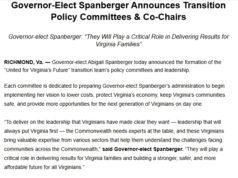( – promoted by lowkell)
In the Washington Monthly, author Colin Woodard is trotting out an explanation of the Virginia election based on cultural heritage.
I’m not talking about “NoVa” versus the Old Dominion, but something much older that suburban Washington: the massive schism between the state’s Tidewater and Greater Appalachian sections, one that has created tensions since the days of the House of Burgesses and, certainly, the secession of West Virginia.
Is there a deeper East vs. West divide within the Old Dominion, beyond the idea of an urban crescent vs. rural Virginia fight?
Let’s find out.
Woodard first points to an analysis of Virginia’s localities based on an urban-rural continuum code used by public health agencies.
I’ll spoil this right now and raise serious questions about using this continuum code for political analysis.
The code focuses on access to specialists and other health care professionals, not necessarily density or rural-urban. For a large urban area like the Washington DC metro, it splits the counties into two divisions: core and fringe. The core county is by definition the central city of the metro area, so in this case DC, and ALL other counties, not just Alexandria and Arlington but also Prince William and Loudoun all the way to Fauquier, are assigned category 2. An analysis starting out with a wide assignment to this second category is going to have serious problems.
When you get to the next category, small metro areas, the code Woodard is using assigns all small metro areas a “3,” putting Roanoke City and more rural counties like Botetourt and Franklin County as the same. Woodard starts off his analysis assuming that Roanoke City is more rural than Fauquier …
Want to see some better explanations of the vote in Virginia? Check out Huffington Post, which has graphs looking at both density and race.
Density:

The need to have a scale that can show the super-dense localities of Arlington and Alexandria hides a lot of the diversity among the less dense. But there’s a clear trend of more dense localities supporting Terry McAullife. Some of the biggest outliers are easy to explain: Winchester leans slightly Republican but has a higher density as an independent city, other similar cities are Colonial Heights, Salem, and Bristol.
And race:

Race explains a lot, especially when you combine with density. The most Democratic, most white localities: Charlottesville, Arlington, and Falls Church, more dense communities. There are few localities that are strongly Republican but with large minority populations, Democrats tend to at least get into the 40% range in Southside rural localities because of a roughly equal black population.
That last observation is the big clue to what Woodard’s analysis is missing. It’s not that the political culture of Virginia’s first families in Tidewater moderates even the rural counties in the East, it’s that the descendents of the slaves brought over by the planters encourages a more Democratic politics.
In fact, here are the rural counties won by Terry McAullife: Surry (almost fifty-fifty), Northampton (36.5% black), Prince Edward (35.82% black, college town), Greensville (majority black), and Brunswick (majority black).
The 2013 Virginia election results are best understood within a broader context of a national electorate that sees Democrats and Republicans increasingly divided not just politically, but geographically too.
A 2007 study by political scientists Richard Morrill, Larry Knopp, and Michael Brown identified political “anomalies,” like rural counties voting Democratic, or larger cities voting Republican. In 2004, the Republican “anomalies” in Virginia were large populated cities and suburbs voting for Bush, like Virginia Beach, Loudoun, Prince William, or Chesterfield. These areas have been trending Democratic in Virginia, with not just Obama but now state candidates like Terry McAullife competitive.
In 2004, the Kerry “anomalies” in Virginia were smaller, more rural counties voting Democratic. They were almost all minority-heavy counties in Southside Virginia with two exceptions: coal heavy, historically union Buchanan and Dickenson in Southwest Virginia, and rural Nelson County, along with smaller suburban county Albermarle outside of Charlottesville. Since that time the former has shifted sharply to the GOP, while Nelson County remains the only mostly white, rural, Democratic county in Virginia. They label Nelson “environmental-progressive” for its political leanings, seeing it as similar to white, rural counties in New England or the Pacific Northwest that similarly lean Democratic. If “political nations” have any role in explaining Virginia’s politics it’s here, not in looking for hints of ancestral planters, that they will be found.



![Saturday News: “Trump’s latest tariff TACO probably won’t make your life more affordable”; “The Epstein Email Cache: 2,300 Messages, Many of Which Mention Trump”; “[MTG] questions if Trump is still the ‘America First’ president”; “Jim Ryan tells all: ‘What did the Governor know, when did he know it?’”](https://bluevirginia.us/wp-content/uploads/2025/11/montage1115-238x178.jpg)







![Saturday News: “Trump’s latest tariff TACO probably won’t make your life more affordable”; “The Epstein Email Cache: 2,300 Messages, Many of Which Mention Trump”; “[MTG] questions if Trump is still the ‘America First’ president”; “Jim Ryan tells all: ‘What did the Governor know, when did he know it?’”](https://bluevirginia.us/wp-content/uploads/2025/11/montage1115-100x75.jpg)

